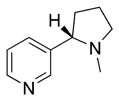Nicotine
Nicotine is an organic compound, a pyrrolidine-like alkaloid found naturally in the nightshade family of plants, such as tobacco and tomatoes. It constitutes 0.3 to 5% of the tobacco plant by dry weight, with biosynthesis taking place in the roots, and accumulates in the leaves. It is a potent nerve poison and is included in many insecticides. In lower concentrations, the substance is a stimulant and is one of the main factors leading to the habit-forming qualities of tobacco smoking. more...
Nicotine has limited carcinogenic effects, inhibiting the body's ability to destroy potentially cancerous cells; however, nicotine does not promote the development of cancer in healthy cells. In addition to the tobacco plant, nicotine is also found in lower quantities in other members of the Solanaceae (nightshade) family, which includes tomato, potato, eggplant (aubergine), and green pepper. Nicotine alkaloids are also found in the leaves of the coca plant.
Chemistry
Nicotine is a hygroscopic oily liquid that is miscible with water in its base form. As a nitrogenous base, nicotine forms salts with acids that are usually solid and water soluble. Nicotine easily penetrates the skin and forms vapors at elevated temperature.
Effects on the body
In small doses nicotine has a stimulating effect, increasing activity, alertness and memory. Repeat users report a pleasant relaxing effect. It also increases the heart rate and blood pressure and reduces the appetite. In large doses it may cause vomiting and nausea. The LD50 of nicotine (that is, the lethal dosage reported to kill 50% of the population) is 50 mg/kg for rats and 3 mg/kg for mice. 40–60 mg can be a lethal dosage for adult human beings.
Repeat users of nicotine very often develop a physical dependency to the chemical. A report released on May 16, 1988 by United States Surgeon General C. Everett Koop stated that the addictive properties of nicotine are similar to those of heroin and cocaine; although many people do not agree with such a comparison. Physical withdrawal symptoms include irritability, headaches, anxiety, cognitive disturbances and sleep disruption. These symptoms peak at around 48–72 hours, and generally cease after two to six weeks.
Although the amount of nicotine inhaled with tobacco smoke is quite small (most of the substance is destroyed by the heat) it is still sufficient to cause dependence. The amount of nicotine absorbed by the body from smoking depends on many factors, including the type of tobacco, whether the smoke is inhaled, and whether a filter is used. For chewing tobacco, often called Dip, Snuff, or snus, which is held in the mouth between the lip and gum, the amount released into the body tends to be much greater than smoked tobacco.
As nicotine enters the body, it quickly gets distributed through the bloodstream and can cross the blood-brain barrier. On average it takes about seven seconds for the substance to reach the brain. It acts on the nicotinic acetylcholine receptors. In small concentrations it increases the activity of these receptors, among other things leading to an increased flow of adrenaline, a stimulating hormone. The release of adrenaline causes an increase in heart rate, blood pressure and respiration, as well as higher glucose levels in the blood. Cotinine is a break-down product of nicotine which remains in the blood for up to 48 hours, and so can be used as an indicator of a person's exposure to smoke. In high doses, nicotine will cause a depolarizing block of the nicotinic acetylcholine receptor, which is the reason for its toxicity and its effectiveness as an insecticide.
Read more at Wikipedia.org



